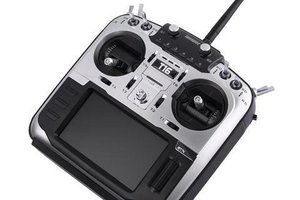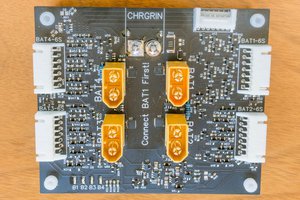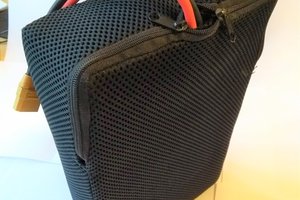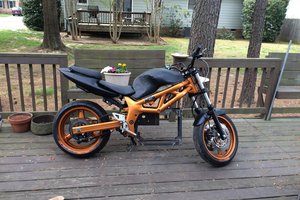LIDL PARKSIDE Battery hacks
How to use LIDL "smart" battery, to power custom electronic such as robots or ebike, Reverse engineering their bluetooth connectivity..
How to use LIDL "smart" battery, to power custom electronic such as robots or ebike, Reverse engineering their bluetooth connectivity..
To make the experience fit your profile, pick a username and tell us what interests you.
We found and based on your interests.
Putting a scope on the CS line with battery connected to the charger, I can see some communication. It seems that the charger has a pull-up to 5V on his CS pin, and the battery generate the data with an open collector (or open drain) output.
About the data itself:
The frame seems constant and identical on my two 8Ah batteries. It is this a repeated sequence (about 4Hz).
Bit rate is 1kHz. At first I was thinking UART, but the stop bit doesn't match any 5-9 bits words with or without parity.
For now this is how I interpret the data: The battery says it can be charged, maybe specifying the current depending on the battery model, cell balancing state, temperature etc, but it doesn't seems to include sensor data itself.
The charger do not respond back anything. I've included a 4.7kHz in series with the CS connection to confirm the data is only set low by the battery. This allowed me also to determine that the pullup value is about 7 kOhm.
Something very useful to remember: When the charger is plugged, the Bluetooth is awakened. This might come handy if we decide to implement the under voltage protection via bluetooth.
I've played with the android app that connect to the battery via bluetooth. At first it looks really interesting with capacity %, charge and discharge current measurement, temperature etc.
I've also took one apart to check the circuit:
We can see a few interesting things:
The bluetooth module is labeled BT7L and we can inf more information here https://developer.tuya.com/en/docs/iot/bt7l?id=K96gqp1dp6iiw It's a system on chip with programable MCU. The lidl app ask me for an OTA update of the battery. Good thing to keep in mind if we really want to push the hack and design a custom firmware ! There is also a pin header near the chipset that I suspect to be a programming or debug interface.
We can see a the balancing circuitry in the middle.
On the left corner there is a push button that allows to wake up the bluetooth, and to show the charge state on 3 LEDs. A long press can enable / disable the BT.
As I expected from other reviews (https://www.reddit.com/r/AskElectronics/comments/s2wswc/how_are_the_new_lidl_parkside_batteries_limit_the/)
the output power pins are directly connected to the cells terminals (via a fuse).
I was thinking that the fuse (top right corner) was acting as a shunt resistor as well, to provide the "charge/discharge current" in the app.
If I were to design this, I'd have put the shunt resistor on the lowside as it simplify a lot the design ! And surely they did not bother with a High side current measurement, this is just a Fuse.
How does the app report the current status then?! Here come the disappointment.
I've hooked up the battery to a resistive load to draw 4Amps from the battery, run the app, and it shows ... 0A !
I think the battery get this information from the tool itself. so there is some sort of communication going on.
From the PCB silkscreen:
I measured 12k Ohm between P- and CS, and 512 kOhm between P- and DS.
CS pin is present on the charger and labeled "ID" (not a "smart" charger). DS in not.
I do not have tools to spy the communication, If anyone have information please comment.
My guess is that the battery need to be compatible with the old line. The fast charger needs to know which type of battery are installed. It also need to read the temperature of the cell to safely charge them.
The tool needs to know the battery voltage to protect from over discharge, but of course it can do this by simply measure it internally.
I've connected a scope to the DS and CS lines while discharging the battery via resistive load and observed nothing (0V).
It is difficult to follow the traces without accessing the bottom of the PCB.
What next?
I really would like to RE the wired communication, but I don't want to buy expensive tool. I will have a look at the communication with the charger.
So I've bought batteries from LIDL labeled PAPS 208 A1
The specs are quite nice for the application I have in mind:.. a DIY ebike !
I've also bought a dual fast charger (not "smart") for 28 Euros.
Create an account to leave a comment. Already have an account? Log In.
Has anyone found out how to reset the PIN? I have tried everything / board de-energized, bridging J1 contacts does not help either. Maybe someone can help. Thanks a lot
The battery controls shutoff not via mosfets but by telling the tool via C pin when to shut off.
There are some common issues with this battery and sometimes it is said that cpu has to be reset via some strange procedures. There is some talk in youtube comments that the cpu on battery motherboard can be reset by shorting two pins of the j1 connector. Any idea which of the two pins could it be?
Pins seem to be like this ( looking at Thomas Flayols picture, counted left to right ):
1 + 3.3v to U1 pin 24
2 - minus
3 ? to U1 pin pin 25
4 ? to U1 pin pin 26
Help with reset would be appreciated. i have a battery stuck in nonworking mode.
Also a repair advice: If your battery stops working and has a burn mark on bluetooth module, you need to remove bluetooth module and replace U3 ( HT7133-1 3.3V ) AND R44 ( 20 ohm ).
hi, did you find out anything? I want to turn on the charger without parkside batteries and charge the batteries of another tool.
my signal is a little different.
the battery is simple, not smart.
You can use this arduino sketch to generate signal to start charging.
#include <Arduino.h>
int bb[] = {8,1,3,1,3,2,2,2,3,1,3,1,3,3,1,204};
#define PIN 7
// the setup function runs once when you press reset or power the board
void setup() {
pinMode(PIN, OUTPUT);
Serial.write("setup done");
}
// the loop function runs over and over again forever
void loop() {
int state = LOW;
long micv = micros();
long cumms = 0;
int len = sizeof(bb)/sizeof(int);
for(int idx=0;idx<len;idx++) {
digitalWrite(PIN, state);
state = 1 - state;
cumms += bb[idx];
while((micros() - micv)/1000<cumms) {
}
}
}
I've used arduino itself to sink the current needed to pull 5V low, which is not the right way to do it, but seems to work fine, at least in my tests. You may want to add an external transistor/mosfet for pulling 5V low, if you decide to build a circuit for this purpose.
You can use CY7C68013A chip wirh sigrock software as a logic analiser. It should be capable to decypher the CAN bus communication (to my knowlage parkside 20v batteries use CAN protocol).
No they don't, they use a stream of 5 bytes whith no flow control neither start or end bits, that identifies the maximum charging current. On the 3° byte, I think.
Can you elaborate a bit about how to decode those 5 bytes? On my PAPS 204 A1, I've seen two different signals, one is sent to initiate charging, the other one to signal charged state.
initiate charging
[ 8 1 3 1 3 2 2 2 3 1 3 1 3 3 1 204]
charged
[ 8 1 3 1 3 2 2 2 4 1 3 1 1 2 2 205]
Numbers are time in ms, odd numbers are for when 5V is pulled low, even numbers signify for how low was 5V released to high state.
Become a member to follow this project and never miss any updates
By using our website and services, you expressly agree to the placement of our performance, functionality, and advertising cookies. Learn More

 Bud Bennett
Bud Bennett

 Rory
Rory
 Neal
Neal
Hi,
Trying to start charging non lidl battery. Battery comes from kaufland.
With arduino directly connected to gnd and ID and sending
int bb[] = {8,1,3,1,3,2,2,2,3,1,3,1,3,3,1,204}; charge not starting.
With sigrok aquired another ori lidl battery:
int bb[] = {8,1,3,1,5,2,2,2,1,1,3,1,3,3,1,207}; charge not starting.
Seems little different signal. Arduino is pulling signal low.
What am I missing ?